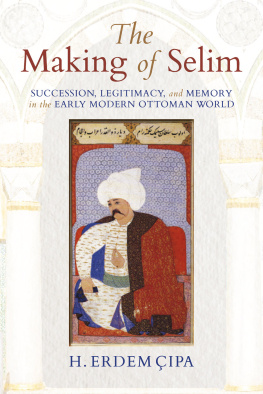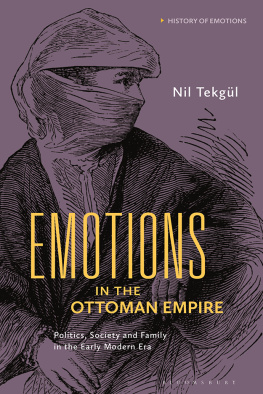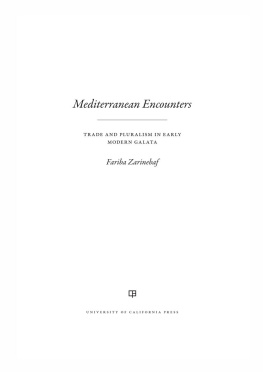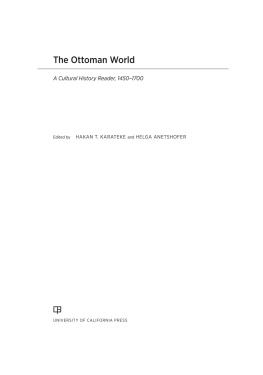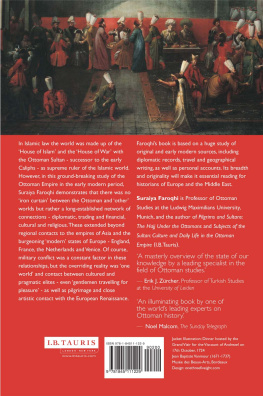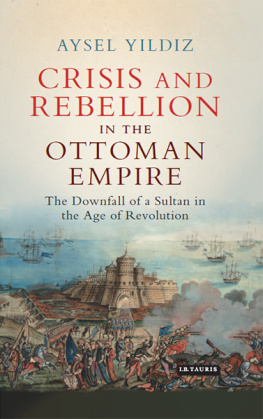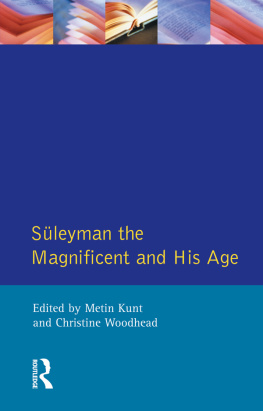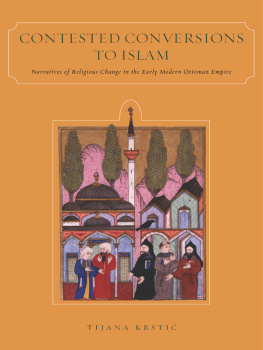Çıpa - The making of Selim: succession, legitimacy, and memory in the early modern Ottoman world
Here you can read online Çıpa - The making of Selim: succession, legitimacy, and memory in the early modern Ottoman world full text of the book (entire story) in english for free. Download pdf and epub, get meaning, cover and reviews about this ebook. City: Bloomington;Indianapolis, year: 2017, publisher: Indiana University Press, genre: Art. Description of the work, (preface) as well as reviews are available. Best literature library LitArk.com created for fans of good reading and offers a wide selection of genres:
Romance novel
Science fiction
Adventure
Detective
Science
History
Home and family
Prose
Art
Politics
Computer
Non-fiction
Religion
Business
Children
Humor
Choose a favorite category and find really read worthwhile books. Enjoy immersion in the world of imagination, feel the emotions of the characters or learn something new for yourself, make an fascinating discovery.
The making of Selim: succession, legitimacy, and memory in the early modern Ottoman world: summary, description and annotation
We offer to read an annotation, description, summary or preface (depends on what the author of the book "The making of Selim: succession, legitimacy, and memory in the early modern Ottoman world" wrote himself). If you haven't found the necessary information about the book — write in the comments, we will try to find it.
Çıpa: author's other books
Who wrote The making of Selim: succession, legitimacy, and memory in the early modern Ottoman world? Find out the surname, the name of the author of the book and a list of all author's works by series.
The making of Selim: succession, legitimacy, and memory in the early modern Ottoman world — read online for free the complete book (whole text) full work
Below is the text of the book, divided by pages. System saving the place of the last page read, allows you to conveniently read the book "The making of Selim: succession, legitimacy, and memory in the early modern Ottoman world" online for free, without having to search again every time where you left off. Put a bookmark, and you can go to the page where you finished reading at any time.
Font size:
Interval:
Bookmark:

THE MAKING OF SELIM
THE MAKING OF SELIM
Succession, Legitimacy, and Memory in the Early Modern Ottoman World
H. Erdem pa
Indiana University Press
Bloomington and Indianapolis
This book is a publication of
Indiana University Press
Office of Scholarly Publishing
Herman B Wells Library 350
1320 East 10th Street
Bloomington, Indiana 47405 USA
iupress.indiana.edu
2017 by H. Erdem pa
All rights reserved
No part of this book may be reproduced or utilized in any form or by any means, electronic or mechanical, including photocopying and recording, or by any information storage and retrieval system, without permission in writing from the publisher. The Association of American University Presses Resolution on Permissions constitutes the only exception to this prohibition.
The paper used in this publication meets the minimum requirements of the American National Standard for Information SciencesPermanence of Paper for Printed Library Materials, ANSI Z39.48-1992.
Manufactured in the United States of America
Library of Congress Cataloging-in-Publication Data
Names: pa, H. Erdem, author.
Title: The making of Selim : succession, legitimacy, and memory in the early modern Ottoman world / H. Erdem pa.
Description: Bloomington : Indiana University Press, 2017. | Includes bibliographical references and index.
Identifiers: LCCN 2016037588 (print) | LCCN 2016050318 (ebook) | ISBN 9780253024237 (cloth : alk. paper) | ISBN 9780253024282 (pbk. : alk. paper) | ISBN 9780253024350 (ebook)
Subjects: LCSH: Selim I, Sultan of the Turks, 1470-1520. | TurkeyHistorySelim I, 1512-1520.
Classification: LCC DR504 .C56 2017 (print) | LCC DR504 (ebook) | DDC 956/.015dc23
LC record available at https://lccn.loc.gov/2016037588
1 2 3 4 521 20 19 18 17
To Christianehaklsn, evimiz saraydr
Contents
Acknowledgments
I REMAIN INDEBTED to various institutions and many friends, colleagues, and family members, who all generously helped me in more ways than one over the years that this study was in the making. It is a great pleasure to finally thank them for all their support, encouragement, guidance, and criticism, without which this book would not have come to fruition.
Research for this study was conducted with the assistance of the Center for Middle Eastern Studies at Harvard University; the Arthur Lehman Scholarship for dissertation research; the Joukowsky Family Foundation grant of the American Research Institute in Turkey; Indiana Universitys College Arts and Humanities Institute research travel grant; and the Research Center for Anatolian Civilizations at Ko University, Istanbul. I would also like to thank these organizations at the University of Michigan, Ann Arbor: the College of Literature, Science, and the Arts; the Islamic Studies Program; the Office of Research; and the ADVANCE Faculty Summer Writing Grants Program. I have been lucky to hold joint appointments in two academic units, and thus my sincere thanks go to the Department of History and the Department of Near Eastern Studies for welcoming me into an intellectually stimulating and nurturing environment. Both departments provided the financial support necessary to complete the final phases of research, copyediting, and indexing for this book.
I conducted the greater part of my research in Istanbul. I am grateful for the assistance provided by the archivists, librarians, and staff at the Ottoman Archives of the Prime Ministry, the Sleymaniye Library, the Istanbul University Central Library, and the Topkap Palace Museum. I thank the staff at the Topkap Palace Museum Archives as well as the former director of the archives, lk Altnda, and the current director, Sevgi Aca. I am particularly grateful to Glendam Nakipolu and Zeynep elik-Atbas at the Topkap Palace Museum Library. I also extend my heartfelt thanks to my dear friend and photographer extraordinaire Hadiye Cangke for providing the digital image reproduced on the cover of this book. Last but not least, I thank Muhittin Eren and Salih Agus of Eren Kitap for helping me locate even the rarest scholarly books.
Throughout the research and writing process, I was fortunate that friends and colleagues agreed to read parts or all of the text at various stages of completion. They offered invaluable advice, insightful comments, and constructive criticism. They saved me from numerous pitfalls and helped me correct several mistakes. Cemal Kafadar has been a true mentor and constant inspiration since the moment I became his adviseea long, long time ago. Over the years, Ycel Demirel and the late Sinasi Tekin taught me the intricacies of Ottoman Turkish. I could not have dealt with the narrative material in Persian without Wheeler Thackston, who introduced me to that language and its poetry during my graduate years. Emine Fetvac and Christiane Gruber shared their expertise in all things art historical, while Mariya Kiprovska and Grigor Boykov generously helped me with all things Rumelian. Kaya Sahin read the complete manuscript and provided thoughtful commentary and constructive criticism. In addition, I benefited immensely from the scholarly guidance and critical insight provided by my senior colleagues in Ann Arbor. Kathryn Babayan and Val Kivelson, my official mentors, offered their friendship along with their academic expertise and helped me to think about my project within a larger theoretical and comparative framework. My unofficial mentor, Gottfried Hagen, generously shared his seemingly endless knowledge of early modern Ottoman history and historiography. Gary Beckman, Kathleen Canning, Katherine French, and Raymond van Dam participated in my manuscript workshop and were joined by Jane Hathaway and Douglas Howard in helping me sprint toward the finish line. I discussed various aspects of this study with and received helpful feedback from many other individuals. I extend my thanks to Nuri Akbayar, Yiit Akn, Helga Anetshofer, Sabri Ates, Evrim Binbas, Gnhan Breki, Giancarlo Casale, Murat Dal, Suraiya Faroqhi, Cornell Fleischer, Skr Ilcak, Ahmet T. Karamustafa, Hakan Karateke, Alexander Knysh, Cihan Yksel Muslu, Can Nacar, Glru Necipolu, Leslie Peirce, Ahmet Tun Sen, Baki Tezcan, Nabil al-Tikriti, and the two anonymous reviewers for Indiana University Press. I would like to express my gratitude for their suggestions and improvements that I incorporated and my apologies for those I resisted. Any faults or weaknesses that remain in this study are entirely my own.
I am also thankful to those who assisted in the production of this book. I owe a great debt of gratitude to Robert Sloan, former editor in chief at Indiana University Press, who supported the project from its inception. Gary Dunham, director of the Press, and Janice E. Frisch, assistant editor, prepared the book for publication in an exceptionally smooth manner. Janet Rauscher copyedited the original manuscript with her typically meticulous touch. It is also thanks to her that this book has an index. Once at the Press, the text benefited from the editing skills and suggestions of Gretchen Otto and Alison Rainey as well. Last but not least, I would like to thank Rachel Trudell-Jones for the beautiful maps she produced.
No words of appreciation can express my gratitude to my family in Istanbul. I am eternally grateful to my parents, Sabiha and Erdin pa; my sister, Sebnem Belgin; and my uncle Ergin Tnaz for having made their unconditional love felt from across the ocean. Whip smart, strong willed, and absolutely adorable, my little niece, Melek is still too young to realize how much dancing, playing, and just being with her invigorated me throughout the writing process.
Next pageFont size:
Interval:
Bookmark:
Similar books «The making of Selim: succession, legitimacy, and memory in the early modern Ottoman world»
Look at similar books to The making of Selim: succession, legitimacy, and memory in the early modern Ottoman world. We have selected literature similar in name and meaning in the hope of providing readers with more options to find new, interesting, not yet read works.
Discussion, reviews of the book The making of Selim: succession, legitimacy, and memory in the early modern Ottoman world and just readers' own opinions. Leave your comments, write what you think about the work, its meaning or the main characters. Specify what exactly you liked and what you didn't like, and why you think so.

